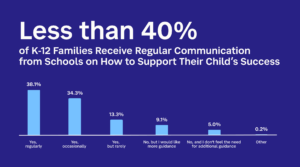Earlier this year, the Biden-Harris Administration committed to supporting schools in the following two focus areas to improve student outcomes: chronic absenteeism and two-way communication. To no surprise, most K12 families see room for improvement as far as these issues are concerned, too.
That’s according to a new survey from edtech solutions provider SchoolStatus, which asked more than 1,000 families about their thoughts on their school’s current communications strategies. Most notably, one-third of families say they’re “uninformed” about their child’s progress in school.
“Families want to be involved in their child’s education, and for them to fully participate, they need relevant, accessible, and actionable information,” SchoolStatus founder and CEO Russ Davis said in a statement.
Moreover, less than 40% of families say they receive regular communication from their schools about what they need to do to support their children’s academics.

Streamlining the process
School-family communications can get confusing. Schools often use a variety of platforms depending on the message. Parents, however, want these efforts simplified.
Sixty-two percent of families believe having a central communications hub would be beneficial. As far as engagement goes, 72% of families prefer emails and 70% prefer text messages.
More from DA: This university’s approach to special educator shortages? Full-tuition scholarships
Improving frequency
As mentioned previously, many parents say they don’t hear from their schools enough when it comes to their kid’s academic progress. Instead, nearly 50% of families said they want daily updates from their school. Another 21% said weekly messages would suffice.
Additionally:
- Forty-five percent of families say their schools don’t communicate frequently enough.
- Forty-two percent of families rated the information communicated by their school as “insufficient.”
- Fifty-three percent believe the information communicated by their school isn’t always easy to decipher.
Increasing attendance via communication
At a time when chronic absenteeism is at the forefront of education leaders’ minds, many families believe schools can leverage communications to reinforce good attendance among students.
For instance, 70% of families think positive updates celebrating their kid’s good or improved attendance would encourage students to continue showing up to school. However, more than 45% of families only hear from their schools about their child’s attendance after they miss school.
“At a time when K12 districts and educators are facing academic setbacks, chronic absenteeism, and more, the findings from our K12 family survey show that districts have a significant opportunity to enhance collaboration with families to address these critical issues and support student success,” Davis explained.









